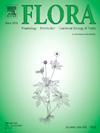Evaluating the oriental beech (Fagus orientalis L.) trees traits under different silvicultural systems in broad-leaved forest
IF 1.8
4区 生物学
Q3 ECOLOGY
引用次数: 0
Abstract
The deciduous-broadleaved oriental beech (Fagus orientalis L.) forests in Hyrcanian region have been logged under different silvicultural systems. In this study, we aim to investigate the influences of the three silvicultural systems including single-tree selection, shelterwood systems and control (unlogged) on the oriental beech tree traits in a broad-leaved forest. A total of 90 beech trees in overstorey were randomly sampled in each applied systems(n = 270), then their crown dimensions and some morphological as well as chemical compounds of leaves were measured. The analysis of variance (ANOVA) showed the impact of different silvicultural systems on all beech tree traits and we found significantly greater basal area, height, volume, crown length and crown width for beech trees under both single-tree selection system and control site(P ≤ 0.01), compared with shelterwood system. The higher values of leaf length, leaf width, leaf area, leaf fresh weight, specific leaf area and leaf perimeter of beech trees were measured in forest managed by single-tree selection system (P ≤ 0.01). Some chemical elements showed significant differences among silvicultural systems, as the highest mean value of N, C, chlorophyll a, and chlorophyll b was observed in the leaf of beech tree in forest managed under single-tree selection system (P ≤ 0.01, P ≤ 0.05), which might be related to nutrient availability in forest. Regression analysis showed that height/diameter ratio and some beech tree traits including DBH, crown width, crown surface area, crown volume were significantly negatively correlated for three silvicultural systems (p = 0.000). In general, uneven-aged silvicultural system including the single-tree selection system, result in variations in beech tree structure that may affect the tree growth and timber quality within beech forest in Hyrcanian region. This is something that must be taken into account when designing forestry projects.
阔叶林不同造林制度下东方山毛榉树木性状的评价
对海卡尼亚地区落叶阔叶东方山毛榉(Fagus orientalis L.)森林在不同的造林制度下进行了采伐。本研究旨在探讨单树选择、防护林制度和不伐制对阔叶林东方山毛榉树木性状的影响。在每个施用系统中,随机抽取90棵山毛榉树(n = 270),测量其树冠尺寸和叶片的一些形态和化学成分。方差分析(ANOVA)表明,不同造林制度对山毛榉各性状的影响均显著高于防护林制度和对照立地(P≤0.01),单树制度和对照立地的山毛榉基材面积、高、体积、冠长和冠宽显著高于防护林制度。单树选育制林下山毛榉的叶长、叶宽、叶面积、叶鲜重、比叶面积和叶周长较高(P≤0.01)。部分化学元素在不同造林系统间存在显著差异,单树选择制度下山毛榉叶片中N、C、叶绿素a和叶绿素b的平均值最高(P≤0.01,P≤0.05),这可能与森林养分有效性有关。回归分析表明,3种造林体系的高径比与胸径、冠宽、冠表面积、冠积等部分性状呈显著负相关(p = 0.000)。一般来说,包括单树选择系统在内的不均匀树龄造林系统会导致山毛榉树木结构的变化,从而影响海卡尼亚地区山毛榉森林内的树木生长和木材质量。这是设计林业项目时必须考虑的问题。
本文章由计算机程序翻译,如有差异,请以英文原文为准。
求助全文
约1分钟内获得全文
求助全文
来源期刊

Flora
生物-植物科学
CiteScore
3.30
自引率
10.50%
发文量
130
审稿时长
54 days
期刊介绍:
FLORA publishes original contributions and review articles on plant structure (morphology and anatomy), plant distribution (incl. phylogeography) and plant functional ecology (ecophysiology, population ecology and population genetics, organismic interactions, community ecology, ecosystem ecology). Manuscripts (both original and review articles) on a single topic can be compiled in Special Issues, for which suggestions are welcome.
FLORA, the scientific botanical journal with the longest uninterrupted publication sequence (since 1818), considers manuscripts in the above areas which appeal a broad scientific and international readership. Manuscripts focused on floristics and vegetation science will only be considered if they exceed the pure descriptive approach and have relevance for interpreting plant morphology, distribution or ecology. Manuscripts whose content is restricted to purely systematic and nomenclature matters, to geobotanical aspects of only local interest, to pure applications in agri-, horti- or silviculture and pharmacology, and experimental studies dealing exclusively with investigations at the cellular and subcellular level will not be accepted. Manuscripts dealing with comparative and evolutionary aspects of morphology, anatomy and development are welcome.
 求助内容:
求助内容: 应助结果提醒方式:
应助结果提醒方式:


